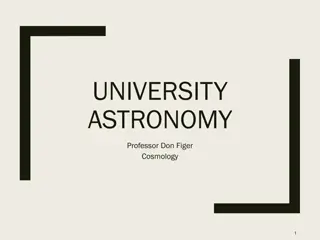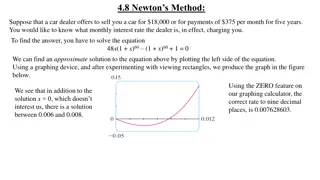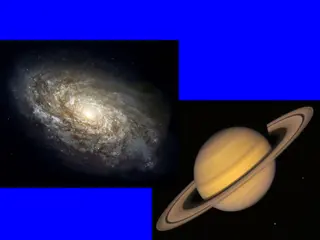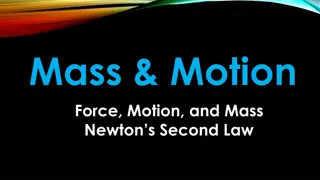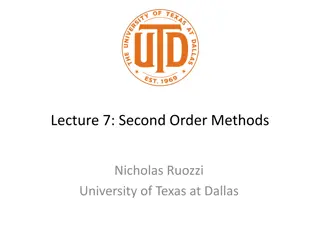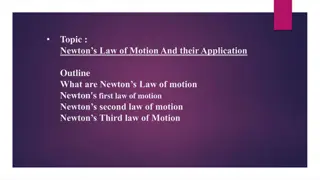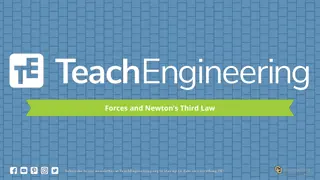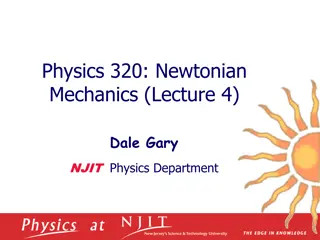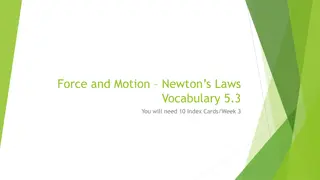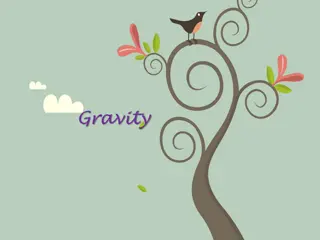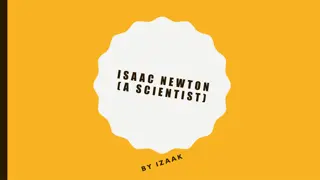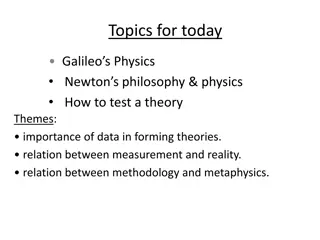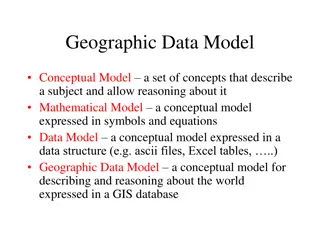Unveiling Universe: Galileo to Newton
Delve into the historical discoveries of Galileo and Newton, as they revolutionized our understanding of the cosmos. Explore Galileo's defiance of traditional beliefs and Newton's groundbreaking laws of motion and gravity. Witness the evolution from questioning Earth's position to defining the principles that govern the universe.
Download Presentation

Please find below an Image/Link to download the presentation.
The content on the website is provided AS IS for your information and personal use only. It may not be sold, licensed, or shared on other websites without obtaining consent from the author.If you encounter any issues during the download, it is possible that the publisher has removed the file from their server.
You are allowed to download the files provided on this website for personal or commercial use, subject to the condition that they are used lawfully. All files are the property of their respective owners.
The content on the website is provided AS IS for your information and personal use only. It may not be sold, licensed, or shared on other websites without obtaining consent from the author.
E N D
Presentation Transcript
PHY1033C/HIS3931/IDH 3931 : Discovering Physics: The Universe and Humanity s Place in It Fall 2015 Prof. Peter Hirschfeld, Physics
Announcements Reading this week: Gregory, Chapter 8 Gregory, Chapter 8 Observations of the moon, The Moon as a Falling Body Newton's Cannon HW5 due Oct. 13; No HW this week Test review session (general) NPB 2205 5:30pm Wednesday
Last time Galileo s discovery of the phases of Venus Galileo s disguised Copernicanism begins to worry Church authorities; G denounced 1613 1616 he goes to Rome to fix things up, is forbidden to teach or hold Copernican ideas; soon probhibition now applied to everyone Galileo searches for way to prove Earth moves; starts thinking about motion at Earth s surface. He decides a ship in uniform (circular) motion (around the Earth) has the same physical laws as one at rest. Thus refutes old if- you-throw-a-rock-up-it-should-come-down-somewhere- else-if-the-Earth-were-moving argument
Midterm exam In class Thursday, Oct. 15 Covers all material up through end of Week 7 (2/19) Bring: ID, scratch paper (calculator optional) Format: 30% mult. choice 40% short answer 30% essay (choice of 2) Review 1 (primarily math): NPB 2205 6pm Monday 10/12 Review 2: (overall review): NPB 2205 5:30pm Wednesday 10/14 1 side paper cheat sheet (handwritten) allowed
Galileo also tried to develop a proof that the earth moved his theory of tides N.B. Kepler had already pointed to Moon as causing tides via something akin to gravitation!
Sir Isaac Newton 1642 1727 Formulated basic concepts and laws of mechanics Universal Gravitation Calculus Light and optics
Newtons First Law (inertia) An object moves with a velocity that is constant in magnitude and direction, unless acted on by a nonzero total force (The total force is defined as the vector sum of all the external forces exerted on the object) An object at rest remains at rest; an object in motion remains in motion, unless acted upon by a force
Inertia: the tendency of an object to continue in its original motion Mass: measure of inertia Or, a measure of the resistance of an object to changes in its motion due to a force A scalar has no direction SI units are kg
Newtons Second Law The acceleration of an object is directly proportional to the net force acting on it and inversely proportional to its mass. Ftot = ma acceleration total force mass Ftot and a are both vectors they have a direction
Here Ftot is the sum of all the forces acting on the object itself. 2 3 Ftot + + = 1 Wait! How does that work? y-component + + = Ftot x-component
Units of Force SI unit of force is a Newton (N) kg 1 N 1 m 2 s US Customary unit of force is a pound (lb) 1 N = 0.225 lb
Clicker question A constant force is exerted for a short time interval on a cart that is initially at rest on an air track. This force gives the cart a certain final speed. The same force is exerted for the same length of time on another cart, also initially at rest, that has twice the mass of the first one. The final speed of the heavier cart is 1. 2. 3. 4. 5. one-fourth four times half double the same as
Gravitational Force Mutual force of attraction between any two objects with mass in the universe Expressed by Newton s Law of Universal Gravitation: m m G F = 1 r 2 g 2
Weight The magnitude of the gravitational force acting on an object of mass m near the Earth s surface is called the weight w of the object W = mgis a special case of Newton s second Law g is the acceleration due to gravity=9.8 m/s2 g can also be found from the Law of Universal Gravitation
Clicker question 3 Krypton is planet with the same radius as earth but 100 times the mass. Superman s weight on that planet would be: A. 10 times that on earth m m F = G 1 r 2 B. Same as that on earth g 2 C. 1000 times that on earth D. 100 times that on earth
Newton's 2nd law We said earlier a force causes a change in an object's state of motion, and also that inertia, or mass, is the quantity which expresses how difficult it is for a given object to change that state. These two concepts were made quantitative by Isaac Newton (b. 1643) in his famous second law of motion: Fnet = ma. acceleration net force mass
Units! The units we use to measure force are (metric system) 1 Newton= 1 kg m/s2
Newton's 3rd law: ``to every action there is an equal and opposite reaction or, ``For every object A which exerts a force on B, B exerts an equal and opposite force on A".
Whoa! Prof. H, Youre telling us that when we push on a wall, it pushes back? when we sit down in a chair, it pushes up? the road pushes cars along it? the air pushes along airplanes? when we drop a ball, not only does it fall to the earth, but that the earth falls up towards the ball? the earth pulls the moon towards it, and the moon pulls the earth towards it? Yes!
Robert Goddard and the NY Times II "...an editorial feature of the New York Times dismissed the notion that a rocket could function in a vacuum and commented on the ideas of Robert H. Goddard...Further investigation and experimentation have confirmed the findings of Issac Newton in the 17th Century, and it is now definitely established that a rocket can function in a vacuum as well as in an atmosphere. The Times regrets the error." --New York Times, July 17 1969
Discussion question A lazy horse argues, I can t pull the wagon since I can never exert more of a force on it than it exerts on me, according to Newton s 3rd law. What is the key reason the cart can really move? C=cart H=horse G=ground
Q: If you push a 200 kg refrigerator on ice with Fnet =1000 N from rest, how fast is it going after 2s? A. V = 10 m/s B. v = 0 C. v = 5 m/s D. 0.1 m/s E. 0.5 m/s
Q: If you push a 200 kg refrigerator on ice with Fnet =1000 N from rest, how fast is it going after 2s? A: a= Fnet /m=1000 N / 200 kg = 5 m/s2. Given acceleration a, we recall equation valid for constant acceleration which tells us the velocity after a certain time: v = at. So v = 5 m/s2 2 s = 10 m/s. Answer: A
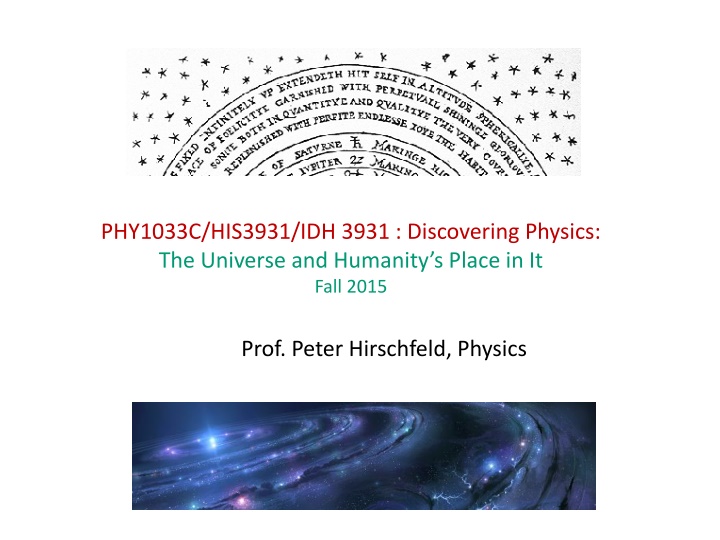


![Read⚡ebook✔[PDF] Io After Galileo: A New View of Jupiter's Volcanic Moon (Sprin](/thumb/21612/read-ebook-pdf-io-after-galileo-a-new-view-of-jupiter-s-volcanic-moon-sprin.jpg)


